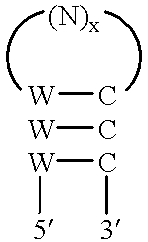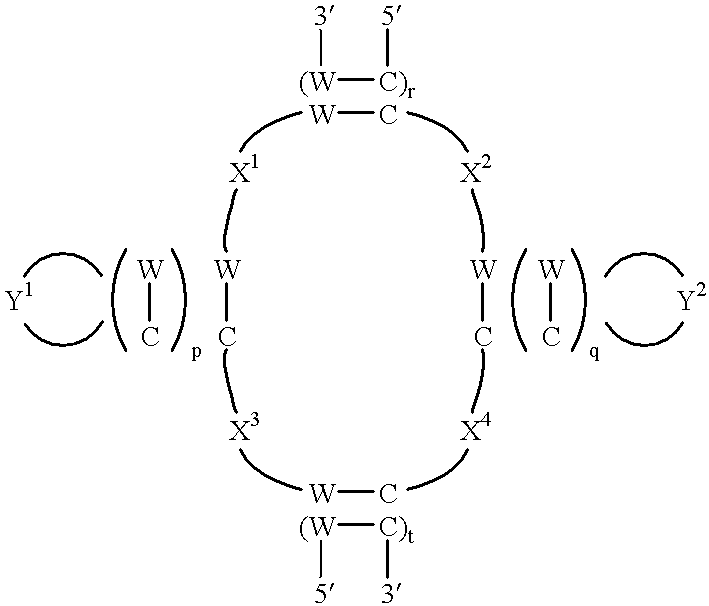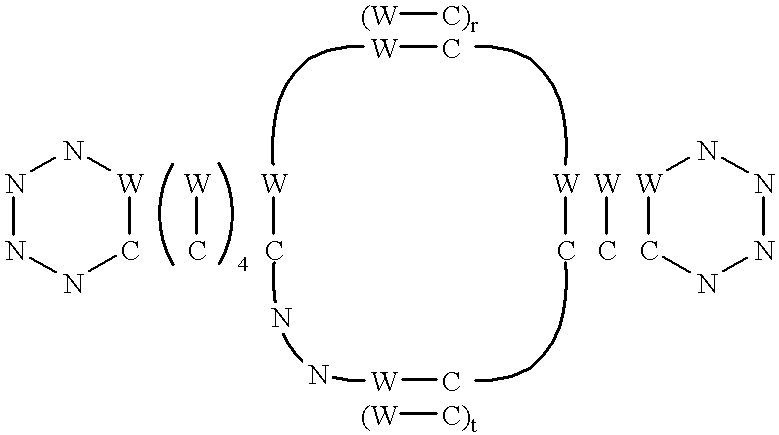Methods and compositions utilizing hepatitis C virus molecules
- Summary
- Abstract
- Description
- Claims
- Application Information
AI Technical Summary
Benefits of technology
Problems solved by technology
Method used
Image
Examples
example 1
Identification of the mIRES
[0216] The effects of mutations in the IIIb loop in HCV were determined by IRES-dependent translation assay.
[0217] A striking reduction in IRES-dependent translation was noted when C at nucleotide 186 was changed to G, thereby creating a W-C base pair with nucleotide 211. Translation was only 39% of that driven by the wild-type sequence. Similarly, replacement of nucleotides 182 and 183 (AC) with CAUW, to form W.C base pairs with nucleotides 214 to 217, reduced translation to 24% of wild-type. Replacement of nucleotides 214 to 217 (AAUG) with GU, to form W.C base pairs with nucleotides 182 and 183, reduced translation to 34% of wild-type.
[0218] The two bulged regions boxed in FIG. 1 are thus critical for RES-driven translation. It is concluded that the binding interaction between eIF3 and the 5'-UTR in HCV genotype 1a requires the motif formed by the annealing of two short linear sequences 5'-G-A-C-G-A-C-C-3' and 3'-C-G-U-A-A-C-U-C-G-5'. These anneal to fo...
example 2
Mutation Analysis of the mIRES
[0220] To probe the critical residues within these 2 short regions, the mIRES was dissected internally.
[0221] The following single nucleotide mutations were made:
1 Nucleotide Wild-type residue Mutation Translation 182 A C 68% G 56% U 76% 183 C A 66% G 63% U 80% 184 G A 30% U 30% 185 A U 39% G 26% C 43% 186 C G 39% 187 C G 39% 211 C A 31% G 21% U 55% 212 U A 52% G 44% C 53% 213 C A 44% G 39% U 78% 214 A C 92% G 73% U 90% 215 A G 93% U 92% 216 U C 72% G 84% 217 G A 100% C 55% U 88%
[0222] Pairs of mutations were also tested. The collected results were as follows:
2 Nucleotide pair Wild-type residues Mutation Translation 182-217 A-G C-G 68% G-G 56% U-G 76% A-A 100% A-C 55% A-U 88% C-A 66% C-C 33% C-U 43% G-A 97% G-C 72% G-U 89% U-A 44% U-C 61% U-U 63% 183-214 C-A A-A 66% G-A 63% U-A 80% C-C 92% C-G 73% C-U 90% A-C 79% A-G 40% A-U 89% G-C 91% G-G 74% G-U 90% U-G 86% U-U 78% 184-213 G-C A-C 30% U-C 30% G-A 44% G-G 39% G-U 78% 185-212 A-U U-U 39% G-U 26% C-U 43...
example 3
Analysis of the interaction between eIF3 and the HCV IRES
Methods
[0225] The ability to interact with the HCV IRES was assessed with a RNA electrophoretic gel mobility shift assay (EMSA). The eIF3 complex was studied with the complete IRES RNA,
[0226] Domain III and deletions of Domain III. The ability of each probe to form a complex with eIF3 was determined by EMSA. In addition, to determine the relative affinity of each IRES RNA, competition analysis was performed with unlabelled RNA.
Preparation of Radiolabelled IRES Probes and Unlabelled Competitors
[0227] Plasmid templates (FIG. 5), linearised with EcoRI, were transcribed with T7 RNA polymerase in the presence of [32p]UTP or UTP and purified by denaturing electrophoresis and subsequent electroelution. The concentration of each prepared RNA was determined by UV spectroscopy and confirmed by denaturing electrophoresis.
EMSA Binding Assay
[0228] IRES-eIF3 binding reactions were performed by incubating the radiolabelled probe (1 nM) with ...
PUM
| Property | Measurement | Unit |
|---|---|---|
| Molar density | aaaaa | aaaaa |
| Molar density | aaaaa | aaaaa |
| Fraction | aaaaa | aaaaa |
Abstract
Description
Claims
Application Information
 Login to View More
Login to View More - R&D
- Intellectual Property
- Life Sciences
- Materials
- Tech Scout
- Unparalleled Data Quality
- Higher Quality Content
- 60% Fewer Hallucinations
Browse by: Latest US Patents, China's latest patents, Technical Efficacy Thesaurus, Application Domain, Technology Topic, Popular Technical Reports.
© 2025 PatSnap. All rights reserved.Legal|Privacy policy|Modern Slavery Act Transparency Statement|Sitemap|About US| Contact US: help@patsnap.com



